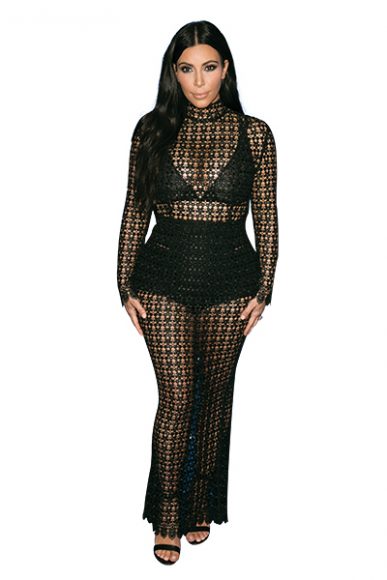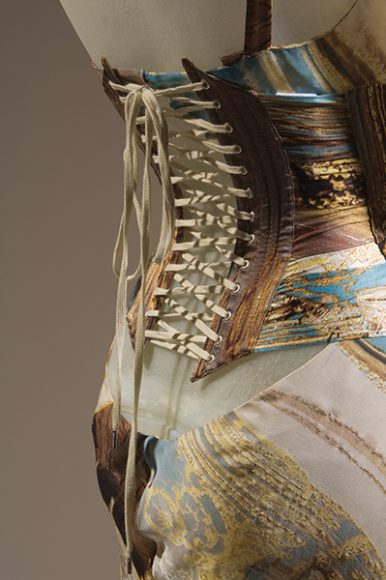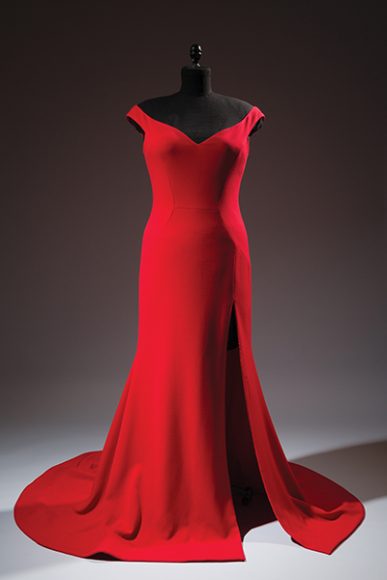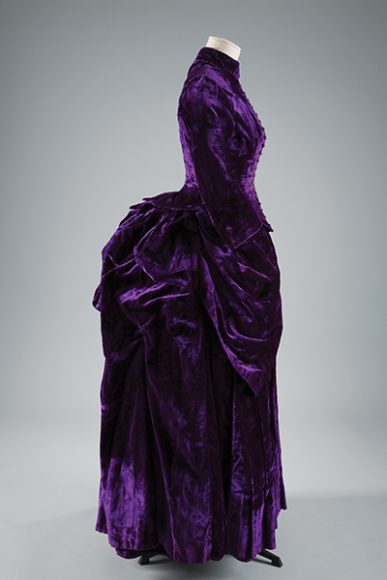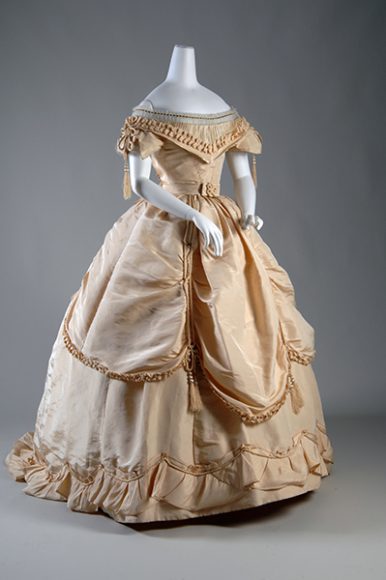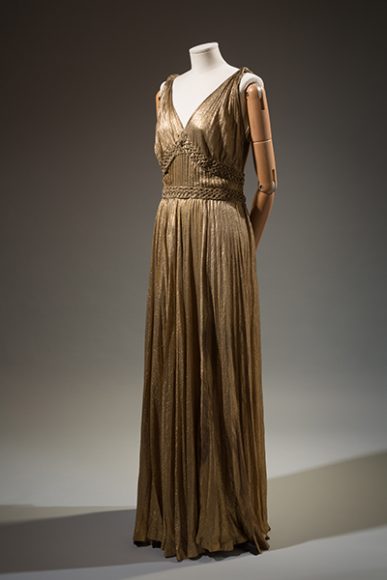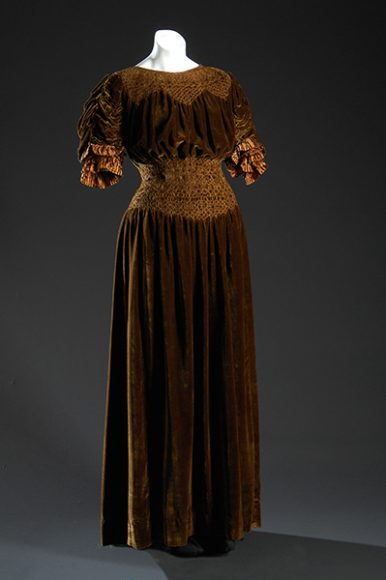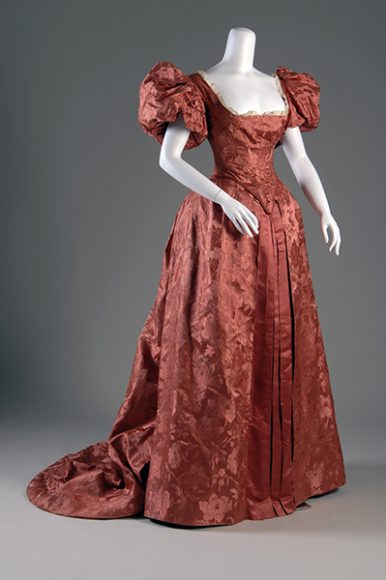What exactly is a fashionable body?
As curator Emma McClendon writes in the brochure for an exhibition at The Museum at FIT, it’s a “cultural construct that has shifted throughout history to emphasize different shapes and proportions.”
Drawing on examples from the 18th century through today, “The Body: Fashion and Physique” is a colorful, thoughtful — and sometimes provocative — exploration through, what McClendon also calls, a “complex history” of the various body shapes that have been considered fashionable in the past 250 years.
What’s to come is clear before you even enter the exhibition, as a 2003 dress fashioned by contemporary artist Cat Chow holds court in a display case right outside the entrance. A closer look at the deceptively simple frock reveals it’s created entirely from plastic tape measures, which, the exhibition text tells us, “highlights society’s preoccupation with the measurements and sizing of clothing.”
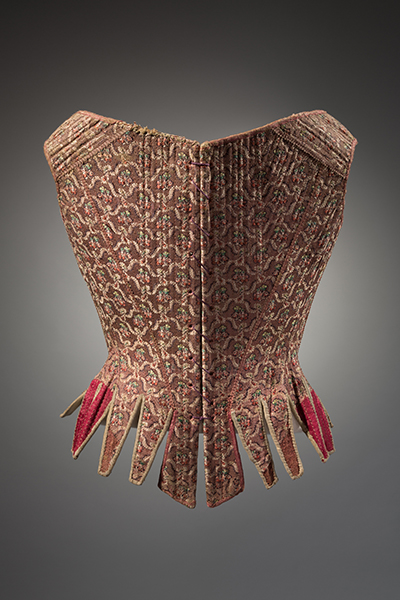
Visitors then step into The Fashion and Textile History Gallery, where an opening vignette features a tunic from Martin Margiela’s spring 1997 collection that effectively turns the wearer into a dress form. Executed in beige linen, the piece is literally clothing as commentary, highlighting the artificial nature of what is considered ideal.
An introductory video is followed by a chronological journey through the centuries, a well-edited selection of 50-plus garments that celebrate, examine and offer food for thought as we watch fashions reflect changing tastes. We see thick and thin, narrow and voluminous, muscular and sleek. We see crinolines and corsets, girdles and flowing gowns, padded shoulders and fashions created to accommodate special needs.
We travel from an 18th-century English brocade stay (later known as a corset) to a formfitting creation from LaQuan Smith, a version of the ensemble worn by Kim Kardashian on a 2015 red carpet. Along the way, there are stops for an 1860s Scottish dress with crinoline, a swoon-worthy tiered 1913 dress featuring a silhouette popularized by Paul Poiret, flapper-style 1920s dresses, a 1951 Christian Dior “New Look” evening dress, a mod 1966 Twiggy mini-dress, a sleekly sexy circa 1976 Halston jumpsuit, a Danskin Unitard (accompanied by video featuring Jane Fonda and Olivia Newton-John that reflects the ’80s exercise craze), a “muscular” man’s sweater from 1991 by Jean Paul Gaultier, a Wonderbra in its 1990s heyday, plus 2017 SPANX “Power Panties.” Yes, it’s a fast-paced and all-encompassing tour.
The objects, all drawn from the museum’s collection, were selected as ideal illustrations of historical points but also help examine the broader relationship between the fashion industry and body politics.
As McClendon, associate curator of costume at the museum, shares, “Garments are supplemented with images from the popular press, fashion media, film and other sources to demonstrate how the fashion industry has contributed to both the marginalization and celebration of certain body types within our culture.”
We follow along as silhouettes change and technological innovations are used to create fashions that reflect ideal body types of the time.
“The fashion industry has historically treated the body (particularly the female body) as malleable, something that can be molded and changed with the cut of a garment, sculpting underwear, diet, exercise and even plastic surgery, depending on the period,” McClendon also writes.
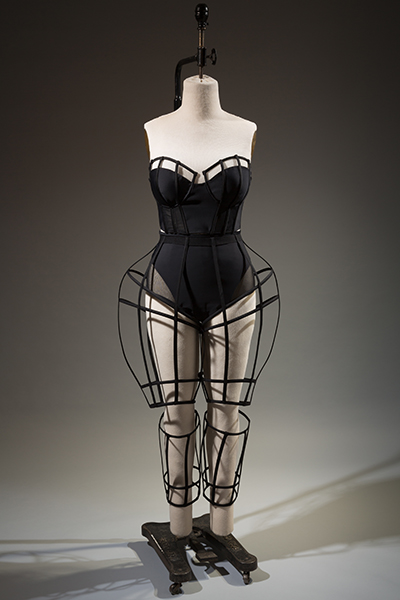
The exhibition has a decidedly current sensibility, taking us into modern days when, McClendon continues, “… the internet and social media have changed the way people engage with fashion. The industry has opened up to a growing cross section of people, and certain designers have embraced a diverse view, including Becca McCharen-Tran of Chromat and Christian Siriano.”
Here, we see Siriano’s 2016 red silk blend crepe faille dress worn by Leslie Jones, Siriano stepping up to design it after the actress tweeted that she was unable to find a designer willing to work with her statuesque form. We also see the Chromat 2015 ensemble, part of its “directional cage pieces” referencing the construction of historical undergarments, that was used as the exhibition’s main image.
As McClendon notes certain contemporary designers, these two in particular, are part of a move to embrace a broader aesthetic.
“On the runway, they use models from across races and sizes, including transgender models and some who wear prosthetics. They also produce their lines in a variety of sizes, rejecting ‘straight’ and ‘plus’ divisions. They are setting an example for the industry with the message that all bodies are beautiful and deserve to be included in fashion.”
On the day WAG toured the exhibition, a mother and her young daughter were among the visitors. The girl, perhaps 7 or 8, attentively watched the video and seemed to be asking questions of her mother throughout the visit. We found it an inspiring moment, perhaps a sign of changing attitudes — no more so than when the girl looked to her mother as they turned to leave and said, “I’m glad we came here.”
“The Body: Fashion and Physique” continues through May 5 at The Museum at FIT on the campus of the Fashion Institute of Technology in Manhattan. For more, visit fitnyc.edu/museum.

